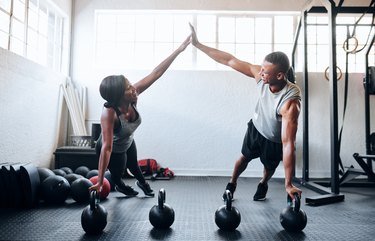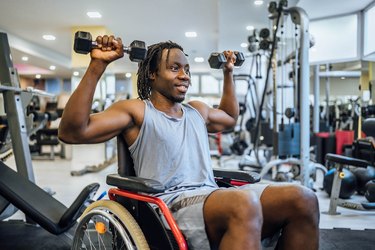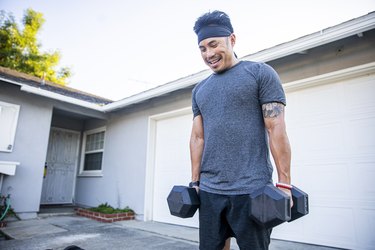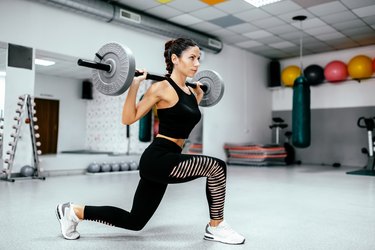
When you're working toward health and fitness goals, you may be interested in knowing more about your body composition — or what percentage of your weight is fat mass and what is lean mass. Specifically, you may be wondering how to measure muscle mass. Muscle mass is, after all, what we're looking to gain more of when we talk about those "gains."
Muscle mass is important for not just that visible muscle definition, but also for keeping you healthy and feeling good throughout the years. Here's how to measure muscle mass, and what to do with your numbers.
Video of the Day
Video of the Day
What Is Muscle Mass?
"Muscle mass refers to the exact amount of muscle in the body," Jason P. Womack, MD, chief of the Division of Sports Medicine at Rutgers University Robert Wood Johnson Medical School and head team physician at Rutgers Athletics, tells LIVESTRONG.
Most people use the terms "muscle mass" and "lean body mass" interchangeably, but they're not exactly the same. Your lean body mass is essentially everything that makes up your body weight, minus fat, Dr. Womack explains. That includes smooth muscle, bones, ligaments and the like. Your muscle mass typically refers to only your skeletal muscle — the muscles you can work and build in the gym, like the biceps, glutes, quads, triceps, deltoids and so many more.
Muscle mass is important for a lot of reasons. "It's our most active tissue and it burns a lot of calories even at rest," explains Wayne L. Westcott, PhD, CSCS, an exercise science professor and researcher at Quincy College in Massachusetts. "Active" really just means that it's always remodeling and repairing itself. When you strength train regularly, your muscle has to do more of that repair work and it uses up even more energy to do so.
Muscle also makes it easier to move and do the things you want to do in daily life. It protects the internal organs to some degree (think: your abdominals acting like a coat of armor, of sorts). Muscle takes some strain off the tendons and other small connective tissues when you do activities that involve impact. It can help reduce pain in areas like the lower back and in some chronic conditions, Westcott says.
Basically, muscle mass is a really great thing to have to perform in the gym and in everyday life.
BMI vs. Muscle Mass
Your body mass index (BMI) is a measure of weight versus height — kg/m2 to be exact. One of the biggest problems with BMI is that it does not take body composition — fat vs. lean body mass — into account.
"If somebody is very active and has a lot of muscle but very little body fat, BMI can be falsely high," Dr. Womack says. Someone who has a low body-fat percentage and is very muscular can end up being classified as having overweight or obesity according to their BMI.
For this reason, "for someone who is active, using lean body mass as a sign of weight and fitness is a better way to estimate where you are health-wise," he says.
Looking at body composition vs. weight can also be helpful if you're trying to lose weight. Westcott notes that people can feel discouraged when they lose pounds slowly, but breaking down how much their percentage of fat vs. lean mass has changed can be more encouraging.
For example, maybe they only lost 10 pounds, but they really lost 20 pounds of fat and gained 10 pounds of muscle. It can be more encouraging, and important, to look at these details instead of just looking at the weight on the scale, Westcott says.
Muscle Mass Averages
It's hard to say what your lean mass and muscle mass percentage should be, because there are so many variables that come into play, including your genetics, health and goals, Dr. Womack says. And the truth is, there isn't really any official recommendation (despite the Centers for Disease Control and Prevention giving a clear recommendation for BMI).
As a general guide, both Dr. Womack and Westcott say that most experts suggest aiming for a body fat percentage between of 20 to 25 percent for people assigned female at birth (AFAB) and 12 to 18 percent for people assigned male at birth (AMAB). That calculates to 75 to 80 percent lean mass for people AFAB and 82 to 88 percent lean mass for people AMAB. This would be considered relatively fit, according to the American College of Sports Medicine (ACSM).
However, remember that's total lean mass, not just muscle mass.
Athletes will likely have even higher percentages of lean mass, likely about 5 to 10 percent lower, Dr. Womack notes.
How to Calculate Muscle Mass
The thing is, it's hard (and not exactly helpful) to suss out what every single tissue in your body weighs.
So generally, the best way to calculate muscle mass and track changes as you work to build muscle is to figure out what percentage of your body weight is lean mass and what percentage is fat. You can then use lean mass as a sort of a stand-in for muscle mass.
For most people, the best way to calculate lean mass is to calculate body fat percentage first, and then subtract that from 100 percent. This gives you your lean mass, so not only your muscle mass — but it's the closest you'll get. Plus, you can keep tabs on muscle gains as your lean mass percentage changes (because other tissues like your organs don't get bigger when you follow a weightlifting routine).
How's that work out into pounds of muscle? Well, if you weigh 200 pounds, and find that 80 percent of your body weight is lean mass, that means you have 160 pounds of lean tissue, including muscle, on your frame.
There are a handful of ways to do this, and some are easy to do at home while others require heavy machinery you'll only find in a doctor's office or sports research lab.
One overall disclosure to keep in mind: Most of these methods for how to calculate muscle mass — ahem, muscle mass percentage calculators you can find online — are not totally accurate, Dr. Womack says.
But by picking one method and sticking with it over time, you'll know the trend is accurate. That way, you can still gain an understanding of how your body composition is changing, even if the exact numbers are a bit off, he says.
Skinfold Caliper Method
This is sort of an old-school, low-tech method of measuring body fat, but it's inexpensive, accessible, and still perfectly legit, Westcott says — as long as it's done by someone who knows what they're doing.
How it's done: A person uses multiple measuring devices, called a calipers, to measure the thickness of skin folds at standardized sites on the body. For people ABAM, the skinfold sites are on the chest, thigh and abdomen; for people AFAB, they are on the triceps, thigh and suprailium (front of the hips), according to the American Council on Exercise (ACE).
Many certified personal trainers are trained in skinfold measurements, and some gyms offer testing for free or at a low cost. You can also try taking your own measurements at home, but it can be difficult to do so and your results might not be very accurate.
Body Circumference Measurements
This manual way of estimating body fat involves using a tape measure to measure the body's circumference at certain spots.
For people AMAB, those spots are the neck and abdomen; for people AFAB, the neck, natural waist and hips, according to the. It's actually part of the U.S. Navy Physical Readiness Program.
Again, it's most accurate to get these measurements from a certified personal trainer or physician.
MRI/Ultrasound
The most accurate way to learn body fat percentage and estimate muscle mass is to do a full-body MRI scan, Dr. Womack says. Unfortunately, this is extremely expensive and inaccessible for most people, he adds.
Similarly, ultrasound is used to measure body fat in a lot of research studies, Westcott says. It allows you to look at subcutaneous (deep-lying) fat layers and muscle layers, and ultrasound machines are relatively easy to use.
Again, though, outside of a research study, there's a slim chance you'll be able to get an ultrasound done for this purpose, especially at an affordable price.
Dual-Energy X-Ray Absorptiometry or DXA Scan
DXA scans work by sending two low-dose X-rays throughout the body,. These move differently through fat mass and lean mass, resulting in a pretty accurate calculation of body composition. According to Dr. Womack, DXA scanning is the most accurate way to measure body fat, and from there, lean mass. It's also used to measure bone density.
The downsides to DXA: It's not widely available, and can be pretty expensive to do. For many people, it's not very realistic to plan to get regular DXA scans to monitor changes in body composition over time.
Water Displacement/Hydrodensitometry
This method is one of the more accurate ways of measuring body fat, but it's also not accessible for most people, Westcott says. It works by measuring how much water your body displaces when fully submerged in water (and even takes lung volume measurements into account). Bone and muscle are denser than water, and fat floats, so a person's weight in water can help reveal things about their body composition.
The downsides are that this type of test is time-consuming and can be uncomfortable for the person being tested — you have to fully submerge yourself multiple times to get a reading on the underwater scale.
Bod Pod/Air Displacement
The Bod Pod looks like it came straight out of a sci-fi movie — you know, one of those vessels you'd climb into and close to preserve your body for the next 100 years.
Except, what it really does is use Air Displacement Plethysmography (ADP) technology to measure your fat mass and lean mass. ADP analyzes changes in pressure to determine volume and ultimately, plugs those values into some physics equations to calculate body composition.
While, according to January 2015 research in PLOS ONE, it's not quite as accurate as DXA, the Bod Pod is simple to use — you just climb in and sit there while it does its thing — and less expensive. There's a good chance a local health club or university offers it for a relatively low price.
Bioelectrical Impedance and Bioimpedance
A few different methods of measuring body fat work by placing devices on your body that send electrical impulses throughout your tissues.
Westcott says that these devices are really variable, and so researchers aren't huge fans. However, they're really easy to use and not invasive — if you've seen body fat scales online that are designed to measure body fat percentage, it likely uses this type of technology.
Dr. Womack actually says this using one of these electrical impedance scales is the best way to measure body fat and muscle mass at home. "It's quick, easy and relatively cheap, and useful as long as you're not worried about the exact number but just looking to follow the trend," he says.
Related Reading
Reasons for Low Muscle Mass
There are several things that can cause a person to have low muscle mass levels, including inactivity, malnutrition and weight loss.
When you diet to lose weight, chances are you're losing both fat and muscle mass.
"Research says that with most diets, 15 to 25 percent of weight loss comes from losing muscle," Westcott says, "which means your metabolism is going to slow down." This is part of the reason why 90 to 95 percent of dieters end up gaining the weight back, he adds.
Losing weight and maintaining or putting on muscle mass requires very intentional changes in exercise and diet, including reducing calories very slowly while strength training and increasing protein intake.
Age-related muscle loss, called sarcopenia, happens slowly over time, and starts as early as your 30s. There's not one explanation for why it happens, but experts believe it is a combination of factors, including neurological decline, hormonal changes, declines in physical activity, chronic illness and poor nutrition.
How to Build Muscle Mass
There are two main things you need to do to build muscle mass: strength train and eat protein.
Westcott notes that you don't have to be in the gym for 2 hours a day to put on muscle mass. Even just doing a short 20-minute strength training workout twice a week can make a difference, he says.
So, focus on training each muscle group a couple times per week, training to fatigue (lifting heavy enough that the final 2 reps are really difficult to eke out), making your workouts progressively harder over time, eating enough high-quality protein throughout the day, and getting enough rest and recovery.
Avoid cutting calories drastically — Dr. Womack says this is a big mistake people make that sabotages any goals of putting on muscle mass. "You need to fuel yourself in the right way," he says.
Everything You Need to Know to Build Muscle Mass
- Centers for Disease Control and Prevention: "About Adult BMI"
- American College of Sports Medicine: "ACSM’s Guidelines for Exercise Testing and Prescription, 10th edition"
- American Council on Exercise: "Percent Body Fat Calculator: Skinfold Method"
- Navy Physical Readiness Program: "Body Composition Assessment"
- PLOS One: "Air Displacement Plethysmography versus Dual-Energy X-Ray Absorptiometry in Underweight, Normal-Weight, and Overweight/Obese Individuals"





